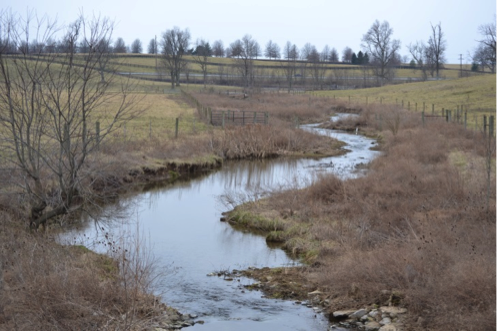Environmental Concerns with Grazing
By Amanda A. Gumbert
 With the many challenges of managing an agriculture operation, environmental concerns often fall low on the priority list. However, incorporating a few key practices can help ensure animal health, improve soil resources, and protect water quality. In addition, these practices can be included in a KY Agriculture Water Quality Plan and help farmers comply with environmental regulations.
With the many challenges of managing an agriculture operation, environmental concerns often fall low on the priority list. However, incorporating a few key practices can help ensure animal health, improve soil resources, and protect water quality. In addition, these practices can be included in a KY Agriculture Water Quality Plan and help farmers comply with environmental regulations.
The KY Agriculture Water Quality Act was passed in 1994 and states that all farms that are 10 acres or more in size need to develop and implement a KY Agriculture Water Quality Plan. Agriculture Water Quality Plans consist of specific best management practices (BMPs) that will be utilized on the farm to protect water quality. These BMPs also make good agronomic sense for the farm, and in some cases may already be part of a sound farm management plan.
Here are some examples of Ag Water Quality Plan BMPs that should be incorporated into your operation:
Livestock BMP #1: Planned Grazing System
This practice is also known as rotational grazing. By utilizing rotational grazing, animals are provided with adequate forage to meet their nutritional needs without overgrazing pastures. When pastures are overgrazed, bare soil is susceptible to erosion and compaction. Furthermore, overgrazed pastures can result in muddy conditions during the winter months. This mud creates problems for the producer as well as a challenge for animals.
Livestock BMP #3: Riparian Area Protection
Riparian areas are also known as streamside buffers. These buffers protect water quality by reducing erosion on stream banks and capturing manure and soil in runoff. Riparian areas can also reduce gulley erosion that causes the loss of pasture areas. These areas can be fenced to exclude livestock as part of a rotational grazing system.
Livestock BMP #4: Limiting Livestock Access to Streams by Fencing, with Alternative Water Systems
When livestock have full access to streams and other water bodies, they create water quality problems by loafing in these areas. Mud and manure can degrade water resources and contaminate livestock drinking water sources. By fencing streams and providing an alternative water source, animals have access to clean water (which results in better health and weight gain) while protecting water quality.
Livestock BMP #11: Nutrient Management
Managing nutrients on the farm is an essential component to protecting water quality. If manures or commercial fertilizers are applied to crop fields on the farm, a nutrient management plan must be developed and followed as part of the Ag Water Quality Plan. A nutrient management plan ensures crop needs are met without the loss of nutrients to surface or ground water. Excess nutrients in water bodies can cause problems for municipal drinking water systems, degrade aquatic habitats, and cause harmful algal blooms, which can adversely affect livestock.
To develop an Ag Water Quality Plan, contact your local Conservation District or Cooperative Extension Service office.
For more information on how to incorporate these and other best management practices into your operation, see the following publications (available online or from your local Cooperative Extension Service office):
AEN-105: Pasture Feeding, Streamside Grazing, and the Kentucky Agriculture Water Quality Plan
ID-175: Riparian Buffers: A Livestock Best Management Practice for Protecting Water Quality
AEN-113: Nutrient Management Concepts for Livestock Producers
Categories:
General
Environment


